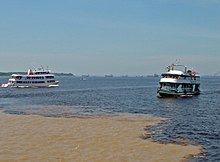
A whitewater river is classified based on its chemistry, sediments and water colour. Whitewater rivers have high levels of suspended sediments, giving the water a pH that is near-neutral, a high electric conductivity and a pale muddy, café au lait-like colour.[1] Whitewater rivers are of great ecological importance and are important to local fisheries. The major seasonal Amazonian floodplains known as várzea receive their water from them.[2][3]
The best-known whitewater rivers are Amazonian and have their source in the Andes, but there are also whitewater rivers elsewhere in South America and in other continents.[1][4][5][6]
Amazonian rivers fall into three main categories: whitewater, blackwater and clearwater. This classification system was first proposed by Alfred Russel Wallace in 1853 based on water colour, but the types were more clearly defined according to chemistry and physics by Harald Sioli from the 1950s to the 1980s.[7][8][9] Although many Amazonian rivers fall clearly into one of these categories, others show a mix of characteristics and may vary depending on season and flood levels.[8][10]
- ^ a b Harris, R.; P. Hutchison (2007). The Amazon (3 ed.). Bradt Travel Guide. p. 100. ISBN 978-1841621739.
- ^ Parolin, P.; L.V. Ferreira; A.L.K.M. Albernaz; S. Almeida (2004). "Tree species distribution in Varzea Forests of Brazilian Amazonia". Folia Geobotanica. 39 (4): 371–383. doi:10.1007/bf02803209. S2CID 30470801.
- ^ Junk, W.J.; M.G.M. Soares; P.B. Bayley (2007). "Freshwater fishes of the Amazon River Basin: their biodiversity, fisheries, and habitats". Aquatic Ecosystem Health and Management. 10 (2): 153–173. doi:10.1080/14634980701351023. S2CID 83788515.
- ^ Vásquez, E.; J. Rey (1989). "A longitudinal study of zooplankton along the Lower Orinoco River and its Delta (Venezuela)". Annales de Limnologie. 25 (2): 107–120. doi:10.1051/limn/1989011.
- ^ Padisák, J.; C.S. Reynolds; U. Sommer (1993), Intermediate Disturbance Hypothesis in Phytoplankton Ecology: Proceedings of the 8th Workshop of the International Association of Phytoplankton Taxonomy and Ecology held in Baja (Hungary), 5–15 July 1991, Springer Science & Business Media, p. 118
- ^ Winemiller, K.O.; A.A. Agostinho; É.P. Caramaschi (2008). "Fish Ecology in Tropical Streams". In Dudgeon, D. (ed.). Tropical Stream Ecology. Academic Press. pp. 107–146. ISBN 978-0-12-088449-0.
- ^ Duncan, W.P.; M.N. Fernandes (2010). "Physicochemical characterization of the white, black, and clearwater rivers of the Amazon Basin and its implications on the distribution of freshwater stingrays (Chondrichthyes, Potamotrygonidae)". PanamJAS. 5 (3): 454–464.
- ^ a b Ríos-Villamizar, E.A.; M.T.F. Piedade; J.G. da Costa; J.M. Adeney; J. Junk (2013). "Chemistry of different Amazonian water types for river classification: A preliminary review".
- ^ Sioli, H., ed. (1984). The Amazon: Limnology and landscape ecology of a mighty tropical river and its basin. Springer. ISBN 978-94-009-6544-7.
- ^ Goulding, M.; M.L. Carvalho (1982). "Life history and management of the tambaqui (Colossoma macropomum, Characidae): an important Amazonian food fish". Revista Brasileira de Zoologia. 1 (2): 107–133. doi:10.1590/S0101-81751982000200001.